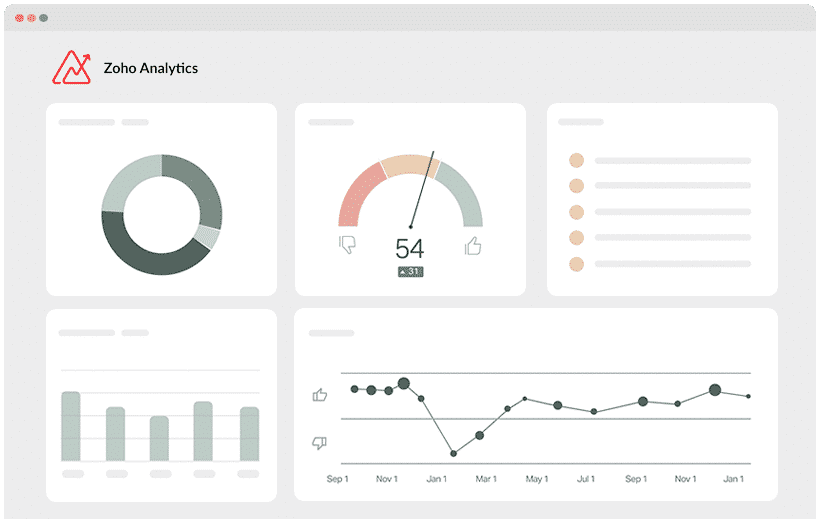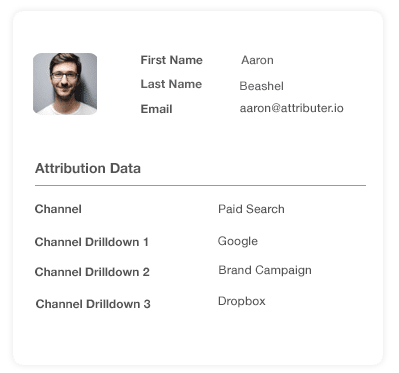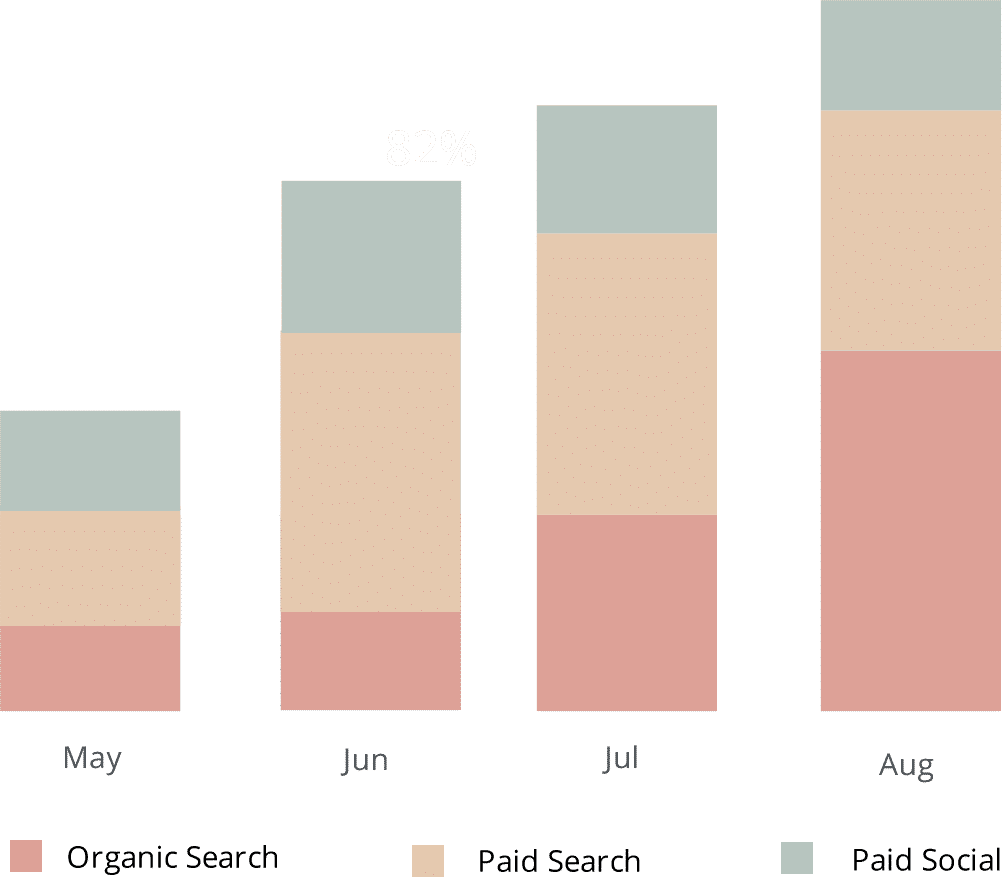The easiest way to track UTM parameters in Zoho Analytics
Learn how to capture UTM parameters and other marketing attribution information so you can run reports in Zoho Analytics that show you what's driving your leads, customers & revenue.

Zoho Analytics is a powerful business intelligence tool that integrates with other Zoho products to make it easy to create reports and dashboards.
However, like most analytics tools, Zoho Analytics can only report on data that you capture and store in your CRM or data warehouse.
So if you want to report on the success of your marketing campaigns in Zoho Analytics, you need to be capturing and storing the UTM parameters that your leads arrive at your website with.
But how do you do this?
In this article, we'll show you the 4 simple steps to capture UTM parameters in your CRM and run reports on them using Zoho Analytics.
What is Attributer?
To put it simply, Attributer is a small snippet of code that you add to your site.
Every time a user reaches your site, Attributer will examine several pieces of technical information (i.e. the UTM parameters in the URL) to figure out where the visitor has come from. Using this technical information, Attributer then groups each visitor into to a series of channels (i.e., Organic Search, Paid Social, Paid Search, etc.) and stores this grouped data in the visitor’s browser as a cookie.
Whenever a visitor submits a form on your site, Attributer sends the UTM parameters and other marketing attribution data (such as their landing page) into your CRM or backend tools, where it can then be sent into Zoho Analytics for reporting.
When the data reaches Zoho Analytics, you can start building reports that answer questions like:
- How many customers have my Google Ads generated?
- What’s the deal size of customers from my LinkedIn Ads vs. customers from my Facebook Ads?
- What’s the total revenue that my blog generated?
- What’s the overall ROI of all our campaigns?
4 steps for analysing UTM parameters in Zoho Analytics
Using Attributer to get UTM parameters into Zoho Analytics is easy. Here's how to do it in 4 easy steps:
1. Add UTM variables to your ads

The first thing to do is to add UTM parameters to your existing and future ads and campaigns so that Attributer will know where your traffic is originating.
Some examples are your ads on social networks like Twitter, Facebook, & LinkedIn, in search engines like Google & Bing, and all bespoke campaign you do in places like trade publications, email newsletters, etc.
2. Add the Attributer code to your website

Afterward, you need to add the Attributer code to your website.
When you’ve signed up for a free trial, a snippet of code will be given to you, which you need to add to your site. If you’ve ever installed the Google Analytics code or any other marketing tools’ code, the Attributer code is very much like them and should be added the same way.
Depending on the CMS system you’re using to manage your website (i.e., WordPress, Squarespace, etc.), there should be an option in the Settings area to add the code to the header.
On the other hand, if you’re using a tag management service like Google Tag Manager, then you can directly add the code through this tool.
Further instructions are provided on our help site.
3. Send the data to your CRM or other tools

Assuming the code is now up and running on your site, Attributer can start to monitor how each of your visitors has arrived at your site. Once Attributer has the information, it will categorise each visitor into a Channel (i.e., Paid Search, Paid Social, etc.) and store this data in the user’s browser as a cookie.
To send this data to your backend tools (like your CRM or wherever you store your customer data), you have to retrieve the data from the cookie. This can be done in two ways:
- Adding hidden fields in forms - By simply adding a few hidden fields to your website forms, Attributer can write the UTM parameters and other attribution data into them. And once the form is submitted, the UTM parameters in the hidden fields are passed onto your backend tools along with the lead’s other information (name, email, number, etc.)
- Getting the data out of the cookie - By adding a simple line of javascript to your website, you will be able to recapture the UTM parameters from the Attributer cookie and pass them to your backend tools. This method is advantageous if you have the ‘Sign up with Google’ button or the ‘Sign up with Facebook’ button, which lets the user sign up for your offering without completing a form.
4. Run reports in Zoho Analytics

Once the UTM parameters and other attribution data have reached your CRM and/or your data warehouse, you can then connect that to Zoho Analytics and start creating reports and dashboards that display your key customer acquisition metrics broken down by channel or campaign.
Having these reports will allow you to determine the answers to some of your toughest marketing questions, such as:
- How many leads did my Facebook Ads generate?
- Which LinkedIn Ad campaigns got the most leads?
- How many sales opportunities came from our Twitter Ads?
- Which Facebook Ads campaigns drove the most pipeline?
- How many customers have we gotten from our Google Ads?
- How much revenue has come from our SEO efforts?
- And much more
Why using Attributer is better than capturing raw UTM parameters
With many other tools for capturing UTM parameters, what makes Attributer a better choice for you?
Unlike other tools, Attributer does much more than just capturing raw UTM parameters. It also does the following:
1. Captures all traffic
Apart from capturing raw UTM parameters and passing them into your CRM and analytics tools, Attributer also gathers attribution information on leads & customers who have arrived at your site through channels with no UTM parameters present (i.e., Organic Search. Paid Search, Organic Social, Direct, etc.)
Having this data means you'll know where every one of your leads & customers come from, not just those that come from channels with UTM parameters.
2. Remembers the data
Traditional UTM parameter capturing tools require the UTM parameter to be present in the URL on the page where your form is completed. This approach could be a problem if the page they submit your form isn’t the exact page they initially landed on.
For instance, imagine a user clicks on your Facebook Ad and is brought to a landing page you created for this campaign.
After they’ve explored and decided that they want to have your product or service, they will click the ‘Get A Quote’ button and be taken to a different page to complete your quote request form.
This means that the page they submit the form isn’t the exact page they first arrived on, which means you lose the UTM parameters.
This won’t happen with Attributer though, because it stores the UTM parameters in a cookie in the user’s browser. So no matter how many pages the user visits before submitting a form, the UTM parameters are safe and will always be passed onto your CRM.
3. Provides cleaner data
If you know anything about working with UTM parameters, it's that the data can get very messy over time, particularly if your ads have been handled by different people or agencies in the past who have used different UTM structures.
For example, imagine a number of your Facebook Ads are tagged with UTM_Source=Facebook (capitalized), others with UTM_Source=facebook (uncapitalized), and others with UTM_Source=fb.
If you try to run reports in Zoho Analytics based on the data gathered by other UTM capturing tools, the results will display 3 different sources, and you’d be fed with the wrong information.
However, Attributer can handle the inconsistencies better because it was designed to expect them. Hence, Attributer can appoint them in the correct channel regardless of these little inconsistencies in UTM usage.
4. Captures landing page data as well
If you’re like most passionate marketers or business owners, you’d have many questions about how your marketing efforts are fairing. From knowing how many leads your blog has generated to the performance of your other content, these are all valuable information you simply need to know.
Attributer can be of great assistance with these too, as it not only collects UTM parameters and other channel data but also collects the landing page (i.e., attributer.io/blog/capture-utm-parameters) and its category (i.e., /blog).
With this landing page data, you will be able see how different sections on your website are performing (like your blog) in terms of leads, customers & revenue, as well as zero in on an individual page’s performance (I.e individual blog posts).
Wrap up
Hopefully, it is now clear how Attributer is more than just the average UTM parameter capturing tool. It does more than just capture UTM parameters and does a lot of work to ensure your data is clean and accurate.
Ready to see what Attributer can do for you? Start your 14-day free trial to see if it’s a fit for your business.
Get Started For Free
Start your 14-day free trial of Attributer today!

About the Author
Aaron Beashel is the founder of Attributer and has over 15 years of experience in marketing & analytics. He is a recognized expert in the subject and has written articles for leading websites such as Hubspot, Zapier, Search Engine Journal, Buffer, Unbounce & more. Learn more about Aaron here.
